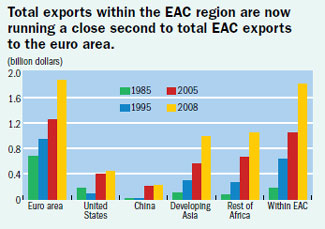Trade in East Africa
Finance & Development, December 2011, Vol. 48, No. 4
Shelley Winston and Carolina Castellanos
Increased intraregional trade and lower tariffs are paving the way for faster growth
OVER the past decade, lower tariffs within the East African Community (EAC) have boosted regional trade, offering the five member countries a route to faster growth. According to the IMF’s latest projections, growth in the EAC region is expected to reach 5.9 percent in 2011—a noticeably faster growth rate than in the rest of sub-Saharan Africa.

During 2000–10, intraregional exports between Burundi, Kenya, Rwanda, Tanzania, and Uganda tripled—from nearly $700 million to nearly $2 billion. Rwanda’s exports have grown the most during this period, from about $1.6 million to $156 million, but are still a fraction of those of the region’s largest economy, Kenya. Kenya’s exports to the other EAC members were about $1.2 billion in 2010. In contrast, export growth in Burundi—the poorest member—has remained constant and imports have declined, mainly because of civil war and inferior infrastructure, such as airports, roads, and docks, which is needed for trade.

At the same time, EAC countries have been exploiting new markets, including those within the region. Exports to other EAC countries are now as high as exports to the euro area, followed by exports to the rest of Africa and developing Asia.
Moreover, tariffs for EAC members in general have fallen substantially. Over the past 15 years, tariffs in the EAC region have been cut from an average of 26.1 percent in 1994 to an estimated 9.2 percent in 2011. But some members are reluctant to completely scrap tariffs because of the loss of tax revenue.

Given the substantial reduction in tariffs and the sizable increases in exports within the EAC, the region is set to achieve sustained higher growth. But to achieve middle-income status over the next 10 to 15 years—a goal of most countries in the region—the EAC must address a number of issues, such as strengthening of institutional reforms and reduction of nontariff barriers. Removing these remaining obstacles could facilitate faster growth and greater diversification of the region’s exports.
Members of the East African Community
The EAC was established in 2000 by Kenya, Tanzania, and Uganda, with Burundi and Rwanda joining in 2007. Its objectives are promotion of duty-free trade and free movement of capital and labor among its members. Despite a slow start, a common market for the region was established in July 2010.
About the database
The data for exports are from the IMF’s Direction of Trade Statistics database, which contains data on the country and area distribution of partner countries’ exports and imports for about 187 countries. The database is available at www.imf.org/external/data.htm Data on tariff rates come from the IMF’s International Financial Statistics database and country authorities.


